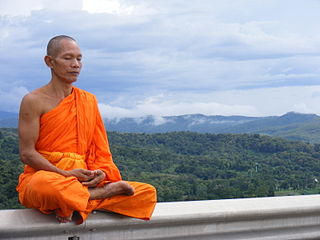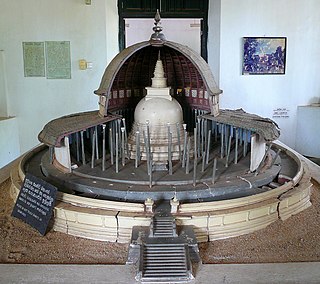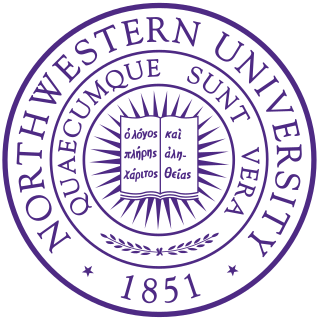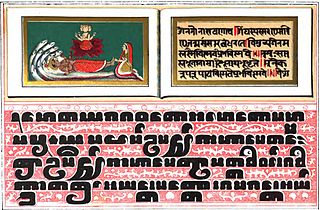
Sangha is a Sanskrit word used in many Indian languages, including Pali, meaning "association", "assembly", "company" or "community". It was historically used in a political context to denote a governing assembly in a republic or a kingdom. It is used in modern times by groups such as the political party and social movement Rashtriya Seva Sangh. It has long been commonly used by religious associations including by Jains and Sikhs.

Theravāda is the most ancient branch of extant Buddhism today and the one that preserved their version of the teachings of Gautama Buddha in the Pāli Canon. The Pāli Canon is the only complete Buddhist canon which survives in a classical Indian language, Pāli, which serves as both sacred language and lingua franca of Theravāda Buddhism. For more than a millennium, Theravāda has focused on preserving the dhamma as preserved in its texts and it tends to be very conservative with regard to matters of doctrine and monastic discipline. Since the 19th century, meditation practice has been re-introduced and has become popular with a lay audience, both in traditional Theravada countries and in the west.

A pratyekabuddha or paccekabuddha, literally "a lone buddha", "a buddha on their own", "a private buddha", or "a silent buddha", is one of three types of enlightened beings according to some schools of Buddhism. The other two buddha types are the arhat and the sammāsambuddha.

Balangoda Ananda Maitreya Thero was a Sri Lankan scholar Buddhist monk and a personality of Theravada Buddhism in the twentieth century. He was highly respected by Sri Lankan Buddhists, who believe that he achieved a higher level of spiritual development through meditation. Sri Lankan Buddhists also considered Balangoda Ananda Maitreya Thero as a Bodhisattva, who will attain Buddhahood in a future life.

Mahinda was a Buddhist monk depicted in Buddhist sources as bringing Buddhism to Sri Lanka. He was the first-born son of the Mauryan emperor Ashoka from his wife Devi and the elder brother of Sanghamitra.

The Anuradhapura Maha Viharaya was an important mahavihara or large Buddhist monastery for Theravada Buddhism in Sri Lanka. It was founded by king Devanampiya Tissa of Anuradhapura in his capital city of Anuradhapura. The Mahavihara was the place where the Theravada Mahaviharan orthodoxy was established by monks such as Buddhaghosa and Dhammapala who wrote commentaries on the Tipitaka and texts such as the Visuddhimagga which are central to Theravada Buddhist doctrine. The monks living at the Mahavihara were referred to as Mahaviharavasins.
Śrāvaka (Sanskrit) or Sāvaka (Pali) means "hearer" or, more generally, "disciple". This term is used in Buddhism and Jainism. In Jainism, a śrāvaka is any lay Jain so the term śrāvaka has been used for the Jain community itself.

Phra Visuddhisamvarathera, known as Ajahn Brahmavamso, or simply Ajahn Brahm, is a British-Australian Theravada Buddhist monk. Currently Ajahn Brahm is the Abbot of Bodhinyana Monastery, in Serpentine, Western Australia, Spiritual Adviser to the Buddhist Society of Victoria, Spiritual Adviser to the Buddhist Society of South Australia, Spiritual Patron of the Buddhist Fellowship in Singapore, Patron of the Brahm Centre in Singapore, Spiritual Patron of the Bodhikusuma Centre in Sydney, Spiritual Adviser to the Anukampa Bhikkhuni Project in the UK, and the Spiritual Director of the Buddhist Society of Western Australia (BSWA). He returned to the office on 22 April 2018 after briefly resigning in March, following a contentious vote by members of the BSWA during their annual general meeting.

Theravada Buddhism is the State religion of Sri Lanka practiced by 70.2% of the Sri Lanka's population. Buddhism has been given special privileges in the constitution and also declared country's official religion by 2nd president of sri Lanka J.R Jayawardene. Sri Lanka is traditionally oldest religious Buddhist country where Buddhist aryan culture is protected and preserved. The island has been a center of Buddhist scholarship and learning since the introduction of Buddhism in the third century BCE producing eminent scholars such as Buddhaghosa and preserving the vast Pāli Canon. Throughout most of its history, Sri Lankan kings have played a major role in the maintenance and revival of the Buddhist institutions of the island. During the 19th century, a modern Buddhist revival took place on the island which promoted Buddhist education and learning. There are around 6,000 Buddhist monasteries on Sri Lanka with approximately 15,000 monks.
Sangharaja is the title given in many Theravada Buddhist countries to a senior monk who is the titular head either of a monastic fraternity (nikaya), or of the Sangha throughout the country. This term is often rendered in English as 'Patriarch' or 'Supreme Patriarch'.

The Amarapura Nikaya is a Sri Lankan monastic fraternity founded in 1800. It is named after the city of Amarapura, Burma, the capital of the Konbaung Dynasty of Burma at that time. Amarapura Nikaya monks are Theravada Buddhists.
The World Buddhist Sangha Council (WBSC) is an international non-government organisation (NGO) whose objectives are to develop the exchanges of the Buddhist religious and monastic communities of the different traditions worldwide, and help to carry out activities for the transmission of Buddhism. It was founded in Colombo, Sri Lanka in May 1966.

The Basic Points Unifying the Theravāda and the Mahāyāna is an important Buddhist ecumenical statement created in 1967 during the First Congress of the World Buddhist Sangha Council (WBSC), where its founder Secretary-General, the late Venerable Pandita Pimbure Sorata Thera, requested the Ven. Walpola Rahula to present a concise formula for the unification of all the different Buddhist traditions. This text was then unanimously approved by the Council.

What the Buddha Taught, by Theravadin Walpola Rahula, is a widely used introductory book on Buddhism for non-Buddhists. Using quotes from the sutras, Rahula gives his personal interpretation of what he regards to be Buddhism's essential teachings, including the Four Noble Truths, the Buddhist mind, the Noble Eightfold Path, meditation and mental development, and the world today.

{{short description
of the founder of Buddhism}}

The Ven. Prof. Hammalawa Saddhatissa Maha Thera (1914–1990) was an ordained Buddhist monk, missionary and author from Sri Lanka, educated in Varanasi, London, and Edinburgh. He was a contemporary of Walpola Rahula, also of Sri Lanka.

Aggamahāpaṇḍita is an honorific Burmese Buddhist title conferred by the Burmese government to distinguished Theravada Buddhist monks.

Ven Bogoda Seelawimala Nayaka Thera is the incumbent Head Priest of the London Buddhist Vihara and the current Chief Sangha Nayaka of Great Britain. He was appointed Chief Bhikkhu of the London Buddhist Vihara on 8 May 2008 following the demise of Ven Dr Medagama Vajiragnana Nayaka Thera. Ven Seelawimala Nayaka Thera hails from the Malwatte Chapter of the Siam Nikaya in Sri Lanka.
A bhikkhunī (Pali) or bhikṣuṇī (Sanskrit) is a fully ordained female monastic in Buddhism. Male monastics are called bhikkhus. Both bhikkhunis and bhikkhus live by the Vinaya, a set of rules. Until recently, the lineages of female monastics only remained in Mahayana Buddhism and thus are prevalent in countries such as China, Korea, Taiwan and Vietnam but a few women have taken the full monastic vows in the Theravada and Vajrayana schools over the last decade. From conservative perspectives, none of the contemporary bhikkuni ordinations are valid.
Sri Lankan Forest Monks' Tradition claims a long history. As the oldest Theravada Buddhist country in the world, several forest traditions and lineages had been existed, disappeared and re-emerged circularly in Sri Lanka. The current forest traditions and lineages in Sri Lanka have been influenced by the Thai and Burmese traditions which descend from the ancient jambudeepa (Indian) and Seehaladeepa traditions.





















